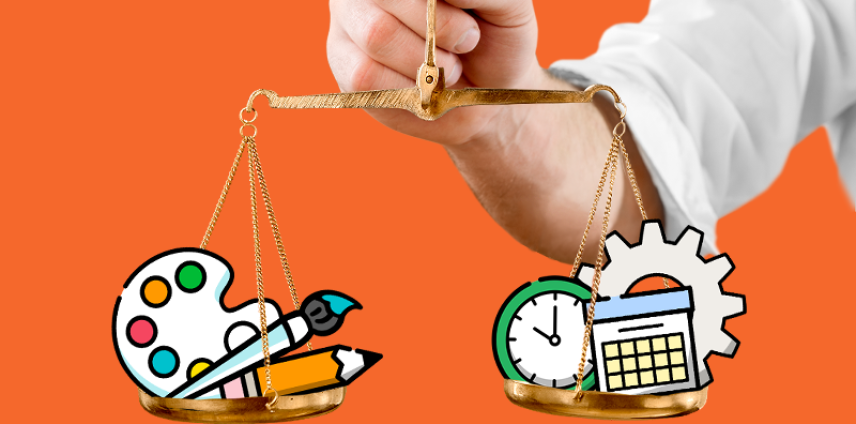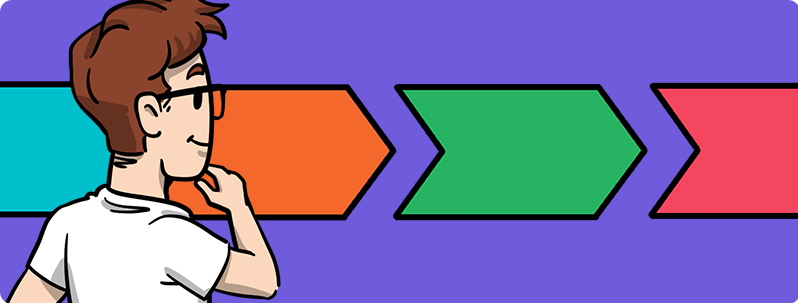How to balance creativity and productivity in team projects
Written by Alex D’Costa | 23rd October 2024

Table of Contents
You want your team to push boundaries and come up with fresh ideas, but there are limitations that come with that. While too much freedom can lead to chaos and missed deadlines, unrealistic productivity goals can crush creativity.
The balance between creative freedom and meeting productivity goals is like juggling while cycling. One wrong move, and you either lose the momentum of work or drop the ball on innovation.
So, how do you keep those creative juices flowing without letting the work pile up? How do you balance creativity and productivity in team projects?
In this blog, we’ll help you find that sweet spot between these two extremes.
Whether you’re managing a small team or leading multiple projects, the 9 tips in this article will help you get the best of both worlds. Let’s get started!

1. Encourage collaboration and communication to unlock new ideas
Collaboration is the foundation of creativity in team projects. But that’s only possible when you’re open to communication. Without it, even the most talented team can get stuck in a rut.
Here’s how you can introduce collaborative brainstorming:
- First, encourage team members to generate new ideas independently. That way, you’ll have more diverse suggestions to work with.
- Next, come together as a team to discuss each idea. But make sure you allot time for each team member to present their ideas.
- Avoid topic digressions, unhealthy debates, or rebuking bad ideas (even the craziest idea can be innovative).
Most importantly, provide regular feedback to your employees so that they stay aligned with the goal.

2. Define clear milestones to keep your team on track
Did you know that 37% of projects fail because of vague objectives and milestones?
So no matter how creative your employees are, you’re killing momentum if the project lacks a clear direction.
Here are some key milestones that you must use:
- Project start and end dates
- Meetings for discussing the project
- Approvals
- Feedback
You can also break down big projects into smaller tasks and use them as milestones.
For example, say you’re working on an explainer video. You can break down this project into stages: script completion, storyboard approval, animation draft, final editing, etc.
But remember, your job doesn’t end with setting milestones. You must regularly check in and track progress. Only then can you keep everyone on the same page, and quickly offer additional support if someone falls behind.
Pro Tip:
The simpleshow video maker uses AI to speed up scriptwriting, making video creation quick and effortless. Its intelligence commenting feature makes collaboration easy—allowing everyone to share input and provide feedback.
You can also break down big projects into smaller tasks and use them as milestones.
3. Provide a supportive and creative environment
Now, there are two parts to this: building a creative zone and a safe zone.
The former focuses more on the physical aspects of the environment—furniture, lighting, aesthetics, inspiring art, stressbusters, etc.
For example, you can take your meetings outside once in a while. Or you can encourage your team to take a 5-minute break from the screen every hour if they are working remotely. Because sometimes, just changing the scenery can spark fresh ideas.
The safe zone refers to psychological aspects. That is, your employees should feel safe to take risks and think out of the box. They shouldn’t fear being judged or penalized for mistakes.
Here are some ways to achieve that:
- Foster a “fail fast, learn faster” culture. That is, mistakes should be seen as learning opportunities, not setbacks.
- Have an open-door policy so that your employees don’t hesitate to approach you.
- Welcome new perspectives and never shun them away (if even they’re bad, think of a way to reframe them).

4. Bridge the gap and keep team collaboration strong in a remote world
Collaboration and remote work—not really the best combination. But with the right approach, you can easily manage remote teams and balance creativity and productivity in team projects.
Here are some strategies that make it easy for employees to collaborate and work in jobs that can be done entirely online:
- Opt for a robust communication tool (Zoom, Microsoft Teams, etc.) for quick and effective collaboration.
- You can also use virtual brainstorming tools to not only collaborate in real-time but also feel connected. (Even though your team is not physically present together.)
- Besides asking for regular updates, initiate casual conversations with your employees to strengthen mutual understanding.
- Use simple language to communicate goals, project briefs, milestones, client expectations, feedback, etc.
- Avoid over-communicating or oversharing unnecessary details. That will only waste more time and distract your employees.
Always remember that effective collaboration lies at the heart of creativity and productivity in team projects. Focus on that, and you’ll master remote team management!
5. Focus on outcomes rather than the process
“When managing creative teams, it’s easy to get caught up in how things are done, rather than focusing on final results. But remember, creativity often thrives in unconventional approaches.”
— [ Ian Nicholls, Founder – AutomobilGarage.com]
Let’s revisit our explainer video example. Instead of micromanaging each step when producing an explainer video, you must focus on the result.
Is the video engaging? Does it provide a solution to the problem? Is it aligned with your project’s goals? If yes, then it doesn’t matter what visual styles or storytelling methods were used.
This shift in focus gives team members the flexibility to approach the problem from different angles, creating room for experimentation, spontaneity, and innovation.
So, if your team consistently hits the target, that means you’ve found a way to balance creativity and productivity in team projects.
6. Automate the mundane for productivity in team projects
Both creativity and productivity are affected when your team is bogged down with repetitive tasks. This is where you must invest in automation.
Going back to our previous example, imagine if you could create that explainer video in minutes. Instead of pouring hours into creating animations manually, you can switch to a tool like simpleshow video maker and quickly convert scripts into videos!
Sounds productive, right?
That way, your team can focus on what’s more important. Like refining the script, honing the message, or brainstorming new video concepts.
Automation doesn’t stop at video creation. Here are some other ways to leverage automation and enhance productivity in team projects:
- You can automate content uploads across multiple channels using Zapier.
- You can schedule posts in advance and automatically monitor online engagement and KPIs using Hootsuite, Sprout Social, etc.
- Tools like Trello, Asana, and ClickUp allow you to automate task allocations based on your workflow.
- Slack lets you set periodic reminders for milestones and deadlines so that everyone stays on track.
- You can use Monday.com to automate daily or weekly progress reports.

7. Celebrate wins by recognizing and rewarding great work
Everyone loves to be recognized. And your employees are no exception.
In fact, acknowledging and rewarding their effort reinforces positive behaviors. As a result, your team feels valued, appreciated, and motivated to achieve more. And that applies to grand breakthroughs as well as the smallest of wins.
Let’s see how you can recognize and reward your team’s contributions:
- Publicly acknowledge their effort in team meetings or group discussions.
- Implement an employee-of-the-month or creator-of-the-month program.
- Avoid vague compliments. Be specific as to how their work contributed to the project’s success.
- Reward them with gift cards, gift baskets, or even extra paid leaves.
- Take your team out for a fully paid lunch after a successful project.

8. Respect work boundaries to prevent burnout
Creativity in team projects thrives on clear work boundaries. So, if you’re constantly pushing your team to deliver great results in less time, you’ll eventually hit the wall.
That’s why you should set clear boundaries around work hours. Avoid burdening them with overtime or pinging them once they’ve clocked out.
Rather, encourage your employees to unplug after work hours and take full lunch breaks.
Lastly, practice what you preach. That is, model these boundaries yourself. Because if you send emails late at night or work through vacations, your team will feel pressured to do the same.
9. Support personal and professional growth for long-term success
This might be shocking to know, but companies that prioritize professional development have a 2x employee retention rate!
In fact, your employees will not only stick around longer but also stay productive and creative when you invest in their career growth.
For instance, if your team is involved in custom t-shirt printing, giving them the opportunity to experiment with different printing techniques and design approaches can enhance their skills while boosting project creativity.
Supporting this kind of hands-on learning will foster a culture of innovation and contribute to the success of your projects.
Simultaneously, personal growth is just as important. You must encourage your team to pursue interests outside of work. You can also foster growth by giving them new opportunities, like a chance to lead a project.
Conclusion
Balancing creativity and productivity in team projects isn’t easy, but that doesn’t mean it’s impossible.
By encouraging collaboration, defining clear milestones, and providing a supportive environment, you can deliver great results without stifling creativity.
The key is to have a process that supports productivity while leaving room for fresh thinking. Project management tools go a long way in streamlining the workflow so you can keep the creative juices flowing without letting deadlines slip.
Ultimately, finding the right balance is an ongoing process—one that evolves with your team. So, find out what works best for you and be flexible!
Author's bio

Alex is a Content Marketing Specialist with over 2 years of experience. She helps SaaS businesses drive organic growth through SEO and data-driven content marketing strategies. When she’s not experimenting with new strategies, you can find her traveling and exploring new places.


